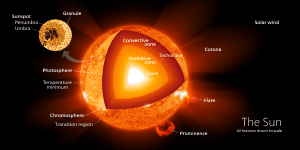Blog
Inner Beauty
28 January 2015
 Wikipedia user Kelvinsong
Wikipedia user KelvinsongThe Sun is so intensely bright that it’s difficult to look at (and you shouldn’t try). When observing the Sun with scientific instruments, we often use filters to diminish the light so that we can observe surface features of the Sun in detail, such as sunspots and the churning of granules due to convection near the surface. But how do we study the interior of the Sun?
One way is through neutrinos generated in the Sun’s core. Unlike light, which can take 20,000 to 150,000 years to travel from the Sun’s core to its surface, neutrinos leave the Sun soon after they are produced. We’ve been able to detect solar neutrinos since the 1960s, but these were neutrinos due to secondary reactions in the core. More recently we’ve been able to observe neutrinos from the principle fusion mechanism known as the pp-chain. From these observations we know the rate at which fusion occurs in the Sun, as well as its central pressure, temperature and density.
Between the core and surface things get a bit more tricky. Surrounding the core is a radiative zone, where the heat of the core moves toward the surface mainly through photon radiation. Surrounding that is a convection zone, where stellar material churns in a cycle. Heated by the interior, the material rises toward the surface. It then cools and sinks toward the interior where the process happens all over again. We know of these levels through helioseismology, which is the study of sound waves traveling through the Sun’s interior. While light takes thousands of years to travel from the Sun’s core to its surface, the solar interior is relatively transparent to acoustic waves, which means they can travel through the Sun at the speed of sound.
As the methods of helioseismology have gotten more sophisticated, we’ve been able to determine some of the characteristics of the convection flow, and what we’ve found is that it’s much more turbulent than originally supposed.1 This means that while our surface and deep interior models are pretty good, our mid-range models aren’t. This isn’t particularly surprising, since the complex transition between the radiative and convective regions is notoriously difficult to model.
But what’s amazing is that we can use sound waves to actually test these models. With methods such as neutrino physics and helioseismology, we can really see the complex beauty of the Sun’s interior.
Gizon, Laurent, and Aaron C. Birch. “Helioseismology challenges models of solar convection.” Proceedings of the National Academy of Sciences 109.30 (2012): 11896-11897. ↩︎